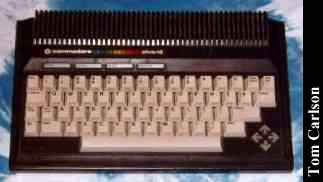Owner: T. Carlson
Location: Williamsburg, VA
Failed Commodore experiment. Actually, a very nice 8-bit. 64K
RAM. Nice graphics ability. Pixels could be any of 128 colors (16
colors at 8 intensity levels). Four software programs included on
the ROMs. None of them were worth much. (The word processor could
only handle 99 lines of text.) This computer was sold as a
successor to the C64. There was another computer, the Commodore
C16, which was a successor to the VIC 20. I have also heard of
one called the C116, which apparently was a C16 with a membrane
keyboard, like a Sinclair.
I caught your entry in the obsolete computer museum. A
funny bit, which brings back memories. I started work at
Commodore in October of 1983, my second job out of college,
after four months of boredom at General Electric. I was hired
to help out on the "TED" project.
TED, you see, was an all-in-one cheap computer chip. It
improved on a number of the things that were done in the C64,
so you didn't need extra SRAMs, you
got more color, etc. Ok, so the sound sucked. Anyway, this
project was started by Jack Tramiel as an answer to the Timex
Sinclair, as well as a replacement for
the VIC-20 (eg, a real computer that
sold for about $100). The basic idea was to sell a 64K
computer, or close, to that market. The result was the
membrane keyboard version called the C116.
By the time I was hired, big nonsense was in full swing.
For unknown reasons, the TED project was split into several
machines. There was the C264, which had the full complement
of stuff, 64K of RAM, etc. The C232 was a scaled-down
version, with 32K and no serial port (TED systems, unlike
C64s, has a real 6551 hardware ACIA).
Eventually, there was the CV364, which I was in charge of
for the two weeks between it becoming an official, for
production unit, and it being cancelled forever. Take the
C264, add a new version of the Magic Voice (we called it
Tragic Voice) speech synthesizer module, add a numeric
keypad, and you have your CV364. I think I still have one of
the two units actually made with production plastic (it was
shown at the '84 Winter CES, but with mock-up casework).
The TED systems had some advantages over the C64. BASIC
3.5 has real graphics commands in it. It used a dynamic ROM
banking scheme, so you got nearly 64K in BASIC (this was
later used on the C128). ROM cartridges, and an internal ROM
slot, could also be banked. Orginally, the C264 was to be
offered with Your Choice of ROM option; EasyCalc, LOGO, etc.
Later, it got the horrible 3+1 package, and was redubbed the
PLUS/4. Some time later, a scaled down 16K version was
introduced as the C16.
All in all, the PLUS/4 wasn't a bad computer, when
compared to others at the same price range. What was wrong
with it? The C64. Why make an incremental, incompatible step
above the C64. Everyone who tried to take on the C64 was laid
to waste: Atari, Coleco Adam, Mattel Aquarius, etc. How could
the PLUS/4 do any better.
The rational becomes clear when you look at the company
politics. Summer of 1983, TED is the answer to Sinclair and
replacing the VIC-20. Fall 1983, we have an explosion of TED
models. Winter 1984, Jack Tramiel leaves Commodore. Summer
1984, his sons follow him, after pushing the PLUS/4 through.
The result: Commodore is left confused about product.


 Back to the Museum!
Back to the Museum!